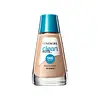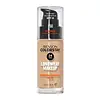Covergirl Clean Matte Liquid Foundation Versus Revlon Colorstay Makeup For Combination/Oily Skin SPF 15
What's inside
What's inside
 Key Ingredients
Key Ingredients

 Benefits
Benefits

 Concerns
Concerns

 Ingredients Side-by-side
Ingredients Side-by-side

Water
Skin ConditioningCyclopentasiloxane
EmollientPropylene Glycol
HumectantTalc
AbrasiveGlycerin
HumectantPEG/PPG-18/18 Dimethicone
EmulsifyingCetyl Ethylhexanoate
EmollientCyclomethicone
EmollientMagnesium Sulfate
Silica
AbrasiveLaureth-7
EmulsifyingArachidyl Behenate
EmollientSodium Dehydroacetate
PreservativeTrihydroxystearin
Skin ConditioningPropylparaben
PreservativeMethicone
EmollientIsopropyl Titanium Triisostearate
EmollientMethylparaben
PreservativeSynthetic Wax
AbrasiveTrisodium EDTA
Ethylene Brassylate
MaskingStearic Acid
CleansingTitanium Dioxide
Cosmetic ColorantIron Oxides
Mica
Cosmetic ColorantWater, Cyclopentasiloxane, Propylene Glycol, Talc, Glycerin, PEG/PPG-18/18 Dimethicone, Cetyl Ethylhexanoate, Cyclomethicone, Magnesium Sulfate, Silica, Laureth-7, Arachidyl Behenate, Sodium Dehydroacetate, Trihydroxystearin, Propylparaben, Methicone, Isopropyl Titanium Triisostearate, Methylparaben, Synthetic Wax, Trisodium EDTA, Ethylene Brassylate, Stearic Acid, Titanium Dioxide, Iron Oxides, Mica
Titanium Dioxide
Cosmetic ColorantZinc Oxide
Cosmetic ColorantCyclopentasiloxane
EmollientWater
Skin ConditioningDimethicone
EmollientTrimethylsiloxysilicate
EmollientPEG-9 Polydimethylsiloxyethyl Dimethicone
EmulsifyingButylene Glycol
HumectantTribehenin
EmollientPhenyl Trimethicone
Skin ConditioningNylon-12
Cymbidium Grandiflorum Flower Extract
Skin ConditioningLactobacillus/Eriodictyon Californicum Ferment Extract
Skin ConditioningLilium Candidum Bulb Extract
Skin ConditioningMalva Sylvestris Extract
AstringentSodium Hyaluronate
HumectantTocopheryl Acetate
AntioxidantBisabolol
MaskingEthylhexyl Palmitate
EmollientTocopherol
AntioxidantAlcohol Denat.
AntimicrobialAlumina
AbrasiveDimethicone/PEG-10/15 Crosspolymer
Methicone
EmollientLaureth-7
EmulsifyingMagnesium Sulfate
Silica
AbrasivePolyglyceryl-3 Diisostearate
EmulsifyingEthylene Brassylate
MaskingTriethoxycaprylylsilane
Dimethicone/Silsesquioxane Copolymer
PEG-12 Glyceryl Dimyristate
Skin ConditioningSalicylic Acid
MaskingSilk Powder
Skin ConditioningSodium Citrate
BufferingDipropylene Glycol
HumectantSilica Dimethyl Silylate
EmollientSerica
HumectantTetrasodium EDTA
Hexylene Glycol
EmulsifyingCaprylyl Glycol
EmollientPhenoxyethanol
PreservativeEthylparaben
PreservativeMethylparaben
PreservativeMica
Cosmetic ColorantIron Oxides
CI 77891
Cosmetic ColorantTitanium Dioxide, Zinc Oxide, Cyclopentasiloxane, Water, Dimethicone, Trimethylsiloxysilicate, PEG-9 Polydimethylsiloxyethyl Dimethicone, Butylene Glycol, Tribehenin, Phenyl Trimethicone, Nylon-12, Cymbidium Grandiflorum Flower Extract, Lactobacillus/Eriodictyon Californicum Ferment Extract, Lilium Candidum Bulb Extract, Malva Sylvestris Extract, Sodium Hyaluronate, Tocopheryl Acetate, Bisabolol, Ethylhexyl Palmitate, Tocopherol, Alcohol Denat., Alumina, Dimethicone/PEG-10/15 Crosspolymer, Methicone, Laureth-7, Magnesium Sulfate, Silica, Polyglyceryl-3 Diisostearate, Ethylene Brassylate, Triethoxycaprylylsilane, Dimethicone/Silsesquioxane Copolymer, PEG-12 Glyceryl Dimyristate, Salicylic Acid, Silk Powder, Sodium Citrate, Dipropylene Glycol, Silica Dimethyl Silylate, Serica, Tetrasodium EDTA, Hexylene Glycol, Caprylyl Glycol, Phenoxyethanol, Ethylparaben, Methylparaben, Mica, Iron Oxides, CI 77891
Ingredients Explained
These ingredients are found in both products.
Ingredients higher up in an ingredient list are typically present in a larger amount.
Cyclopentasiloxane, or D5, is a silicone used to improve texture of products and trap moisture.
D5 is considered lightweight and volatile. Volatile means it evaporates quickly after application. Once evaporated, D5 leaves a thin barrier that helps keep skin hydrated.
It is also an emollient. Emollients help soften the skin and prevent water loss. Silicones create a silky texture in products. D5 helps other ingredients become more spreadable.
Studies show D5 is safe to use in skincare products. We recommend speaking with a skincare professional if you have concerns.
Learn more about CyclopentasiloxaneWe don't have a description for Ethylene Brassylate yet.
Laureth-7 is created by the ethoxylation of lauryl alcohol using ethylene oxide. Lauryl alcohol is a fatty alcohol with hydrating properties.
This ingredient is an emulsifier and cleansing ingredient. As an emulsifier, it is used to prevent ingredients from separating. It also helps cleanse the skin by gathering dirt, oil, and pollutants to be rinsed away.
Magnesium Sulfate is a salt. More specifically, it is an epsom salt, or the bath salt used to help relieve muscle aches.
Despite having ‘sulfate’ in the name, it isn’t a surfactant or cleansing agent like sodium lauryl sulfate. Unlike those sulfates, magnesium sulfate doesn’t have the same cleansing or foaming properties (it's simply a type of salt).
In cosmetics, Magnesium Sulfate is used to thicken a product or help dilute other solids. It is a non-reactive and non-irritating ingredient.
One study shows magnesium deficiency may lead to inflammation of the skin. Applying magnesium topically may help reduce inflammation.
You can find this ingredient in sea water or mineral deposits.
Learn more about Magnesium SulfateMethicone is a type of silicone and is a simpler form of dimethicone.
Silicones are used to enhance the texture of products and have emollient properties. Methicone is used to give products a silky texture and improves spreadability.
Methylparaben is a preservative and is a paraben. It is used to prevent the growth of fungus, mold, and other harmful bacteria. Parabens are chemicals used as preservatives in both cosmetics and food.
Methylparaben can be synthetically created. It can also be found naturally in some fruits, such as blueberries.
Oftentimes, Methylparaben is combined with other parabens to help increase the shelf life.
The safety of Methylparaben is currently being studied. While ongoing studies are looking into the safety of parabens, the results have been very mixed. Some studies have not found Methylparaben to be harmful.
Learn more about MethylparabenMica is a naturally occurring mineral used to add shimmer and color in cosmetics. It can also help improve the texture of a product or give it an opaque, white/silver color.
Serecite is the name for very fine but ragged grains of mica.
This ingredient is often coated with metal oxides like titanium dioxide. Trace amounts of heavy metals may be found in mica, but these metals are not harmful in our personal products.
Mica has been used since prehistoric times throughout the world. Ancient Egyptian, Indian, Greek, Roman, Aztec, and Chinese civilizations have used mica.
Learn more about MicaSilica, also known as silicon dioxide, is a naturally occurring mineral. It is used as a fine, spherical, and porous powder in cosmetics.
Though it has exfoliant properties, the function of silica varies depending on the product.
The unique structure of silica enhances the spreadability and adds smoothness, making it a great texture enhancer.
It is also used as an active carrier, emulsifier, and mattifier due to its ability to absorb excess oil.
In some products, tiny microneedles called spicules are made from silica or hydrolyzed sponge. When you rub them in, they lightly polish away dead skin layers and enhance the penetration of active ingredients.
Learn more about SilicaTitanium dioxide is a mineral UV filter widely used in sunscreens and cosmetics.
It is one of only two UV filters officially classified as “mineral” by regulatory agencies, the other being zinc oxide.
Titanium dioxide provides broad-spectrum protection mostly in the UVB and UVAII range, with some protection in the UVAI range.
While its UVA protection isn’t as strong as zinc oxide’s, the difference is minor.
A common myth is that mineral UV filters reflect UV light. However, modern research shows titanium dioxide absorbs UV radiation like chemical filters (~95% absorption & 5% reflection).
Thanks to its non-irritating nature, titanium dioxide is suitable for sensitive, acne-prone, or redness-prone skin. It is unlikely to cause "eye sting" like other sunscreen ingredients.
A major drawback of this ingredient is its white cast and thick texture. This is why mineral sunscreens often leave a white cast and are less cosmetically elegant than chemical/hybrid sunscreens.
To improve white cast and spreadability, micronized or nano-sized titanium dioxide is often used.
There are ongoing concerns surrounding nano-titanium oxide's impact on marine ecosystems.
There is no conclusive evidence that any form of titanium oxide (or any other sunscreen ingredients) will cause harm to marine ecosystems or coral reefs. The science is still developing but many consumers are keeping a close eye on this issue.
Please note, many destinations have reef-safety sunscreen rules. For instance, the U.S. Virgin Islands advises all visitors to use non-nano mineral sunscreens.
Nano mineral sunscreens once raised safety concerns about absorption into skin.
Extensive research has shown that they do not penetrate healthy or damaged skin; they remain safely on the surface and the top layer of dead skin (stratum corneum).
You'll likely find titanium dioxide bundled with alumina, silica, or dimethicone. These ingredients help make titanium dioxide highly photostable; this prevents it from interacting with other formula components under UV light.
Learn more about Titanium DioxideWater. It's the most common cosmetic ingredient of all. You'll usually see it at the top of ingredient lists, meaning that it makes up the largest part of the product.
So why is it so popular? Water most often acts as a solvent - this means that it helps dissolve other ingredients into the formulation.
You'll also recognize water as that liquid we all need to stay alive. If you see this, drink a glass of water. Stay hydrated!
Learn more about WaterThis ingredient is a combination of red, black, and yellow iron oxide pigments. This combination of colors is usually found in foundation, because it results in a "skin" color.